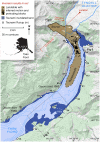The 2015 landslide and tsunami in Taan Fiord, Alaska
- PMID: 30190595
- PMCID: PMC6127189
- DOI: 10.1038/s41598-018-30475-w
The 2015 landslide and tsunami in Taan Fiord, Alaska
Abstract
Glacial retreat in recent decades has exposed unstable slopes and allowed deep water to extend beneath some of those slopes. Slope failure at the terminus of Tyndall Glacier on 17 October 2015 sent 180 million tons of rock into Taan Fiord, Alaska. The resulting tsunami reached elevations as high as 193 m, one of the highest tsunami runups ever documented worldwide. Precursory deformation began decades before failure, and the event left a distinct sedimentary record, showing that geologic evidence can help understand past occurrences of similar events, and might provide forewarning. The event was detected within hours through automated seismological techniques, which also estimated the mass and direction of the slide - all of which were later confirmed by remote sensing. Our field observations provide a benchmark for modeling landslide and tsunami hazards. Inverse and forward modeling can provide the framework of a detailed understanding of the geologic and hazards implications of similar events. Our results call attention to an indirect effect of climate change that is increasing the frequency and magnitude of natural hazards near glaciated mountains.
Conflict of interest statement
The authors declare no competing interests.
Figures





References
-
- Roe GH, Baker MB, Herla F. Centennial glacier retreat as categorical evidence of regional climate change. Nature Geoscience. 2016;10:95–99. doi: 10.1038/ngeo2863. - DOI
-
- Gruber, S. & Haeberli, W. Permafrost in steep bedrock slopes and its temperature‐related destabilization following climate change. Journal of Geophysical Research Earth Surface112, 10.1029/2006JF000547 (2007).
-
- Coe JA, Bessette-Kirton EK, Geertsema M. Increasing rock-avalanche size and mobility in Glacier Bay National Park and Preserve Alaska detected from 1984 to 2016 Landsat imagery. Landslides. 2017
-
- Deline, P., Hewitt, K., Reznichenko, N. & Shugar, D. Rock avalanches onto glaciers in Landslide Hazards Risks and Disasters 263–319, 10.1016/b978-0-12-396452-6.00009-4 (Elsevier, 2015).
-
- McColl ST. Paraglacial rock-slope stability. Geomorphology. 2012;153–154:1–16. doi: 10.1016/j.geomorph.2012.02.015. - DOI
Publication types
LinkOut - more resources
Full Text Sources
Other Literature Sources
Miscellaneous

